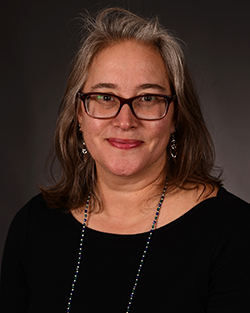College of Science
Physics professor Dr. Jennifer Birriel teaches students skills by involving them in research
 Morehead State Professor of Physics Dr. Jennifer Birriel became interested in science at a very early age. Her father was a chemist, and he used to read her articles from National Geographic when she was six or seven years old, breaking down complex scientific ideas into a language she could understand. Birriel became fascinated with stars, so her parents bought her a telescope.
Morehead State Professor of Physics Dr. Jennifer Birriel became interested in science at a very early age. Her father was a chemist, and he used to read her articles from National Geographic when she was six or seven years old, breaking down complex scientific ideas into a language she could understand. Birriel became fascinated with stars, so her parents bought her a telescope. Living in the suburbs of Kansas City, Kansas, she was frustrated that she couldn't see much with her telescope due to light pollution. So, when she was 14, she started researching light pollution and discovered it has numerous adverse effects on animals, humans and the environment. She said it interferes with the mating, feeding and migration habits of birds, insects and animals, wastes energy and contributes to air and water pollution, and may even contribute to rates of certain types of cancer in shift workers.
Birriel said she didn't dive into light pollution research professionally until she became a mother.
"It wasn't until I actually came here, and I had kids that I started thinking about what else would be negative about blocking out the objects in the sky," she said. "So that all kind of had its origins and the fact that I was a parent, and I was thinking about leaving a better planet for my son and daughter, and then I just started doing more research. I'm actually trained as an astrophysicist so measuring the night sky brightness is right up my alley."
Throughout her career, Birriel has engaged students in active scientific research. In 2017, Birriel and two research students participated in the Citizen Continental-America Telescopic Eclipse (CATE) Experiment. MSU's team was one of more than 60 across the US that used data collected during that year's solar eclipse to map solar coronas. Birriel is currently working with a research student to use data collected during that experiment to explain how the shape of the solar corona varies with distance and examine the effects of the solar flattening parameter. She and her students are preparing for the next solar eclipse in 2024 when they will collect more data and compare it to the 2017 data to see if the shape of the solar coronas has changed.
Birriel's students are also using laser pointers and fluorescent dyes to learn about the stellar spectrum of light. One of Birriel's capstone students is using a camera and light detection devices to map anomalies in light pollution patterns.
Birriel and her students have published their work numerous times and presented their findings at several conferences. Most recently, Birriel was invited to speak at the American Association of Physics Teachers' annual winter meeting, held virtually Jan. 6-8. Birriel discussed how students and researchers can use spreadsheet software such as Microsoft Excel in the lab to help with complex computations.
Birriel has conducted research projects with more than ten students at MSU and said she finds it rewarding not just academically but also personally.
"Being able to see them grow intellectually and have a kind of that moment where they're like, wow, this is neat and, you know, this means something and I'm actually using the stuff that I learned in a textbook to solve an actual problem. It's just seeing that passion grow."
To learn more about Birriel's research, email her at j.birriel@moreheadstate.edu.
To explore programs in Morehead State's Department of Physics, Earth Science and Space Systems Engineering, visit www.moreheadstate.edu/phes, email phes@moreheadstate.edu or call 606-783-2381.
